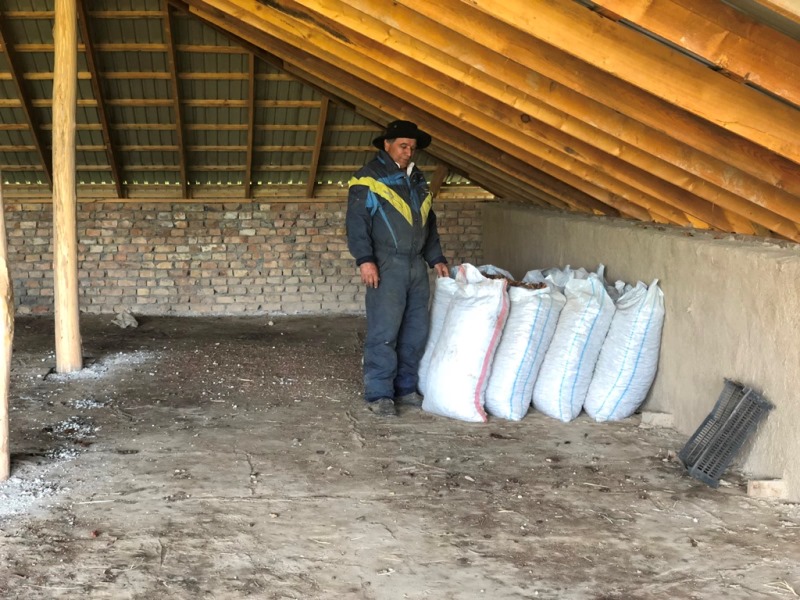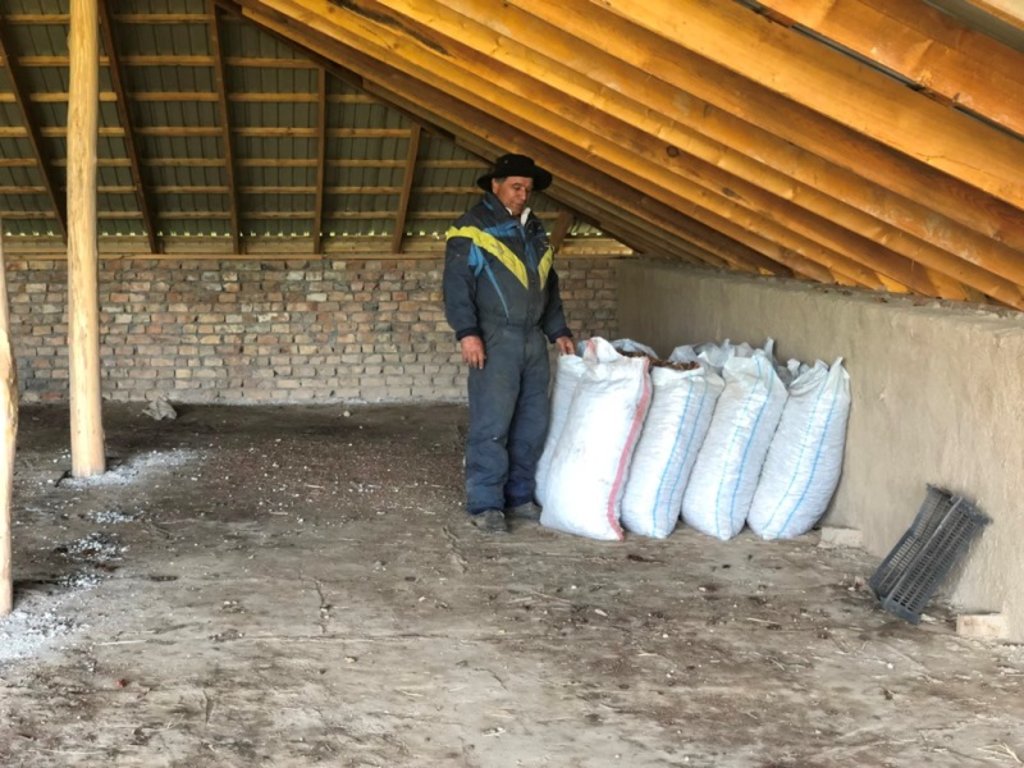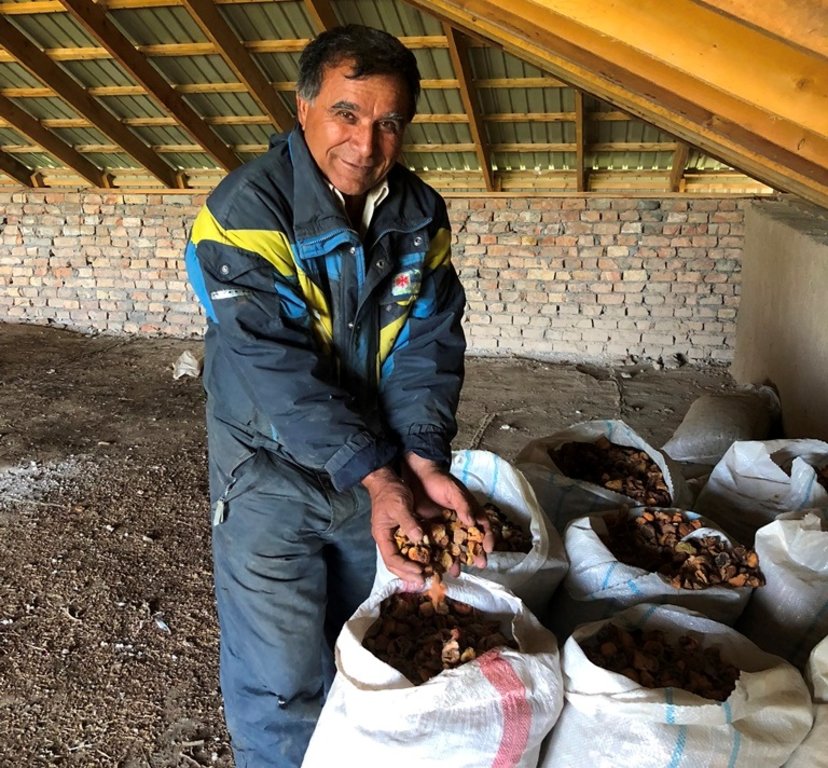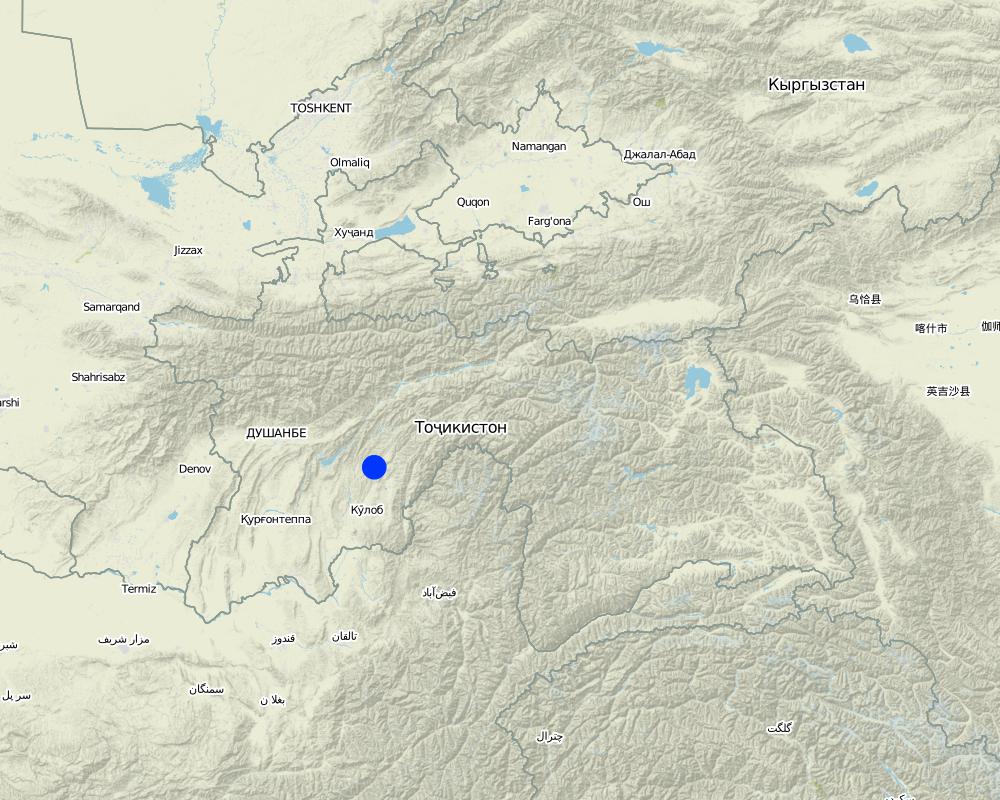Saving harvest of the orchards through drying [ប្រទេសតាហ្ស៊ីគីស្ថាន]
- ការបង្កើត៖
- បច្ចុប្បន្នភាព
- អ្នកចងក្រង៖ Kamolidin Abdulloev
- អ្នកកែសម្រួល៖ –
- អ្នកត្រួតពិនិត្យ Farrukh Nazarmavloev
Пешгирии талафоти мева таввасути қоқкунӣ
approaches_3902 - ប្រទេសតាហ្ស៊ីគីស្ថាន
ពិនិត្យមើលគ្រប់ផ្នែក
ពង្រីកមើលទាំងអស់ បង្រួមទាំងអស់1. ព័ត៌មានទូទៅ
1.2 ព័ត៌មានលម្អិតពីបុគ្គលសំខាន់ៗ និងស្ថាប័នដែលចូលរួមក្នុងការវាយតម្លៃ និងចងក្រងឯកសារនៃវិធីសាស្ត្រផ្សព្វផ្សាយ
ឈ្មោះគម្រោងដែលបានចងក្រងឯកសារ/ វាយតម្លៃលើវិធីសាស្ត្រផ្សព្វផ្សាយ (បើទាក់ទង)
Environmental Land Management and Rural Livelihoods (ELMAR)ឈ្មោះអង្គភាពមួយ (ច្រើន) ដែលបានចងក្រងឯកសារ/ វាយតម្លៃលើវិធីសាស្ត្រផ្សព្វផ្សាយ (បើទាក់ទង)
Committee for Environment Protection of Tajikistan (Committee for Environment Protection of Tajikistan) - ប្រទេសតាហ្ស៊ីគីស្ថាន1.3 លក្ខខណ្ឌទាក់ទងទៅនឹងការប្រើប្រាស់ទិន្នន័យដែលបានចងក្រងតាមរយៈវ៉ូខេត
តើពេលណាដែលទិន្នន័យបានចងក្រង (នៅទីវាល)?
02/06/2018
អ្នកចងក្រង និង(បុគ្គលសំខាន់ៗ)យល់ព្រមទទួលយកនូវលក្ខខណ្ឌនានាទាក់ទងទៅនឹងការប្រើប្រាស់ទិន្នន័យដែលបានចងក្រងតាមរយៈ វ៉ូខេត:
បាទ/ចា៎
2. ការពណ៌នាអំពីវិធីសាស្ត្រផ្សព្វផ្សាយ SLM
2.1 ពណ៌នាសង្ខេបខ្លីពីវិធីសាស្ត្រផ្សព្វផ្សាយ
Gardeners in different ways store apples, pears, pomegranates, grapes and nuts for winter, but the main part of the harvest used for the animals. Proposed approach help land users to save all the harvest using drying methods.
2.2 ពណ៌នាលម្អិតពិវិធីសាស្ត្រផ្សព្វផ្សាយ
ពណ៌នាលម្អិតពិវិធីសាស្ត្រផ្សព្វផ្សាយ:
People usually used fresh fruits and store it in a different way for the winter. Therefore, to preserve freshness and juiciness, apples and granates reserved them in jars.There are many opportunities for drying fruits in Safedshahrak village of Lohuti jamoat. The village has more than 10 hectares of orchards. The village is located far from the district center at a distance of 18 km, in the north-east part of the district and at an altitude of 1300 m. The climate is humid and with abundant rainfall. Local people are mainly engaged in growing potatoes, gardening and livestock breeding. Industrial enterprises do not function in the district. A small number of women study at Medical College and a vocational technical school or attend a special high and secondary schools in Dushanbe to get any skills. However, working places are only available in the central district hospital and general education schools for 5-6% of the total number of qualified women.
The project provides small-scale grants at the village level for groups of households to implement rural production and land management investments, as well as related small-scale infrastructure investments.Villages will prioritize investments based on a fixed budget for each type of rural investment, determined by the number of households
The CIG established in Safedshahrak village, which consisted of 25 members, and they recognize their work on drying fruits as an advantage in the first place. With the support of the project, the CIG was purchased and installed tools and equipment for drying fruit, and put production into operation.
Abdukodir Gozaev, a head of CIG, made all preparations for the construction of a warehouse for drying fruits, organized work on harvesting and drying fruit according to the plan. As a result, the rural people collected 60 tons of fresh fruit, which were dried. There are 3.5 tons of dried apples, 3.5 tons of cherries, 1 ton of rose hips and 0.5 tons of plums in the group's warehouse. Collected products were sold, and the sale profit was TJS 21950 (2,488$). The CIG head paid to the population from the funds received after the sale. In the future, he intends to prepare special boxes and sell them with packed dried fruit. This type of activity will give the opportunity to adapt their products to market requirements
2.3 រូបភាពនៃវិធីសាស្ត្រផ្សព្វផ្សាយ
2.5 ប្រទេស/តំបន់/ទីតាំងកន្លែង ដែលវិធីសាស្ត្រផ្សព្វផ្សាយត្រូវបានអនុវត្តន៍
ប្រទេស:
ប្រទេសតាហ្ស៊ីគីស្ថាន
តំបន់/រដ្ឋ/ខេត្ត:
Kulob Region, Khovaling District
បញ្ជាក់បន្ថែមពីលក្ខណៈនៃទីតាំង:
Jamoat Lohuti, Safedshahrak village
មតិយោបល់:
An approach was implemented in the Khovaling district, Lohuti jamoat, Safedshahrak village
Map
×2.6 កាលបរិច្ឆេទនៃការចាប់ផ្តើម និងបញ្ចប់នៃវិធីសាស្រ្តផ្សព្វផ្សាយនេះ
សូមបញ្ជាក់ឆ្នាំដែលបានបង្កើតឡើង:
2016
ឆ្នាំបញ្ចប់ (ប្រសិនបើវិធីសាស្ត្រផ្សព្វផ្សាយត្រូវបានឈប់ប្រើប្រាស់):
2017
មតិយោបល់:
An approach technical part done during the 2 month and after project monitored it, presently CIG is managing and maintaining
2.7 ប្រភេទនៃវិធីសាស្ត្រផ្សព្វផ្សាយ
- ផ្អែកលើគម្រោង/កម្មវិធី
2.8 គោលបំណង/ទិសដៅសំខាន់នៃវិធីសាស្ត្រផ្សព្វផ្សាយ
Supporting gardeners to improve the management of the orchards and to save their harvest using drying fruit approach, by this way to raise the household income
2.9 លក្ខខណ្ឌអនុញ្ញាត ឬរារាំងការអនុវត្តន៍បច្ចេកទេសដែលស្ថិតនៅក្រោមវិធីសាស្រ្តផ្សព្វផ្សាយ
សង្គម/វប្បធម៌/ និងតម្លៃនៃសាសនា
- អំណោយផល
People usually used fresh fruits or stored apples, pears, grapes and nuts for winter only as the juice and did not drying them. Duirng the season gardenners lost thousands tons of the fruits that were the main part of their harvest
As the result of the project there were appeared an opportunity to save all the harvest from their orchards and additionaly have income from that
ភាពអាចរកបាននៃធនធានហិរញ្ញវត្ថុ និងសេវាកម្ម
- អំណោយផល
Gardeners used only fresh fruits and did not use the main part of their harvest as a result, the rural people collected 60 tons of fresh fruit, which were dried. There are 3.5 tons of dried apples, 3.5 tons of cherries, 1 ton of rose hips and 0.5 tons of plums in the group's warehouse. Collected products were sold and have a good profit. The CIG head paid to the CIG Members (local Land Users) from the funds received after the sale. In the future, he intends to prepare special boxes and sell them with packed dried fruit. This type of activity will give the opportunity to adapt their products to market requirements.
បរិបទនៃស្ថាប័ន
- អំណោយផល
As the result of the project established the Common Interest Group that will manage and maintain the approach in future
ចំណេះដឹងស្តីពី SLM និងការទទួលបានការគាំទ្រផ្នែកបច្ចេកទេស
- រារាំង
Lack of knowledge on SLM approaches and technologies There was organised different type of SLM relative trainings on behalf of the project during the approach implementation
3. ការចូលរួម និងតួនាទីរបស់ភាគីពាក់ព័ន្ធ
3.1 អ្នកពាក់ព័ន្ធដែលបានចូលរួមក្នុងវិធីសាស្ត្រផ្សព្វផ្សាយ និងតួនាទីរបស់ពួកគេ
- អ្នកប្រើប្រាស់ដីក្នុងតំបន់/សហគមន៍
Gardeners (CIG Members)
Local land users prioritized investments based on a fixed budget for each type of rural investment determined by the number of households. Within a plan of action, participants decided on the allocation of investments to groups of households using rules that limit the funding for any one household.
- អ្នកឯកទេសគ្រប់គ្រងដីប្រកបដោយចីរភាព/ទីប្រឹក្សាបច្ចេកទេសកសិកម្ម
Reprezentatives from the project parners and government institutions
Reprezentaives from the facilitating organisations and professors (as TOT trainers) from the Institutions and academies involved during the trainings
- រដ្ឋាភិបាលថ្នាក់មូលដ្ឋាន
Hukumat and jamoat reprezentatives
Jamoat representatives were involved in Participatory Rural Appraisal (PRA) that was used as the main pre-assessment mechanism to analyze the socio-economic and environmental situation in the selected pilots, The RRC(Rayon Review Committee) will consider the combination of proposed sub-projects within the overall context of the rayon and project. The committee will review and accept proposals that meet project guidelines and provide clearance to the IG for the release of project funding to the accounts of relevant CIGs.
3.2 ការចូលរួមរបស់អ្នកប្រើប្រាស់ដីក្នុងតំបន់/ សហគមន៍ក្នុងតំបន់ក្នុងដំណាក់កាលផ្សេងគ្នានៃវិធីសាស្រ្តផ្សព្វផ្សាយ
| ការចូលរួមរបស់អ្នកប្រើប្រាស់ដីក្នុងតំបន់/សហគមន៍ក្នុងតំបន់ | សូមបញ្ជាក់នរណាត្រូវបានចូលរួម ព្រមទាំងពណ៌នាសកម្មភាពទាំងនោះ | |
|---|---|---|
| ការរៀបចំផែនការ | អសកម្ម | Project beneficiaries (CIG Members) interviewed and consulted during the social assessment conducted in the project design process which then influenced project approaches. |
| ការអនុវត្តន៍ | អន្តរកម្ម | During the Participatory and Community Action Planning Villagers (CIG Members) made grant allocation decisions. After the supporting CIGs proposals, they had managed grant funds and purchased needed materials and products individually |
| ការត្រួតពិនិត្យ និងវាយតម្លៃ | អសកម្ម | active participation of the local land users during the monitoring process |
3.3 គំនូសបំព្រួញ (ប្រសិនបើមាន)
3.4 ការសម្រេចចិត្តលើការជ្រើសរើសបច្ចេកទេស SLM
សូមបញ្ជាក់តើអ្នកណាជាអ្នកបានសម្រេចចិត្តក្នុងការជ្រើសរើសបច្ចេកទេសដើម្បីយកមកអនុវត្តន៍:
- អ្នកប្រើប្រាស់ដី ដោយមានការគាំទ្រពីអ្នកជំនាញឯកទេស SLM
ចូរពន្យល់:
Local land users prioritized investments based on a fixed budget for each type of rural investment determined by the number of households. Within a plan of action, participants decided on the allocation of investments to groups of households using rules that limit the funding for any one household.
សូមបញ្ជាក់ តើការសម្រេចធ្វើឡើងដោយផ្អែកលើអ្វីជាមូលដ្ឋាន:
- វាយតម្លៃទៅលើចំណេះដឹងស្តីអំពី SLM ដែលបានចងក្រងជាឯកសារបានត្រឹមត្រូវ (ផ្អែកលើភស្តុតាងជាមូលដ្ឋានដើម្បីសម្រេចចិត្ត)
- Project initial phases
4. ជំនួយបច្ចេកទេស ការកសាងសមត្ថភាព និងការគ្រប់គ្រងចំណេះដឹង
4.1 ការកសាងសមត្ថភាព/ បណ្តុះបណ្តាល
តើវគ្គបណ្តុះបណ្តាលបានផ្តល់ឱ្យអ្នកប្រើប្រាស់ដី/អ្នកពាក់ព័ន្ធផ្សេងៗទៀតដែរឬទេ?
បាទ/ចា៎
សូមបញ្ជាក់តើអ្នកណាត្រូវបានបណ្តុះបណ្តាល:
- អ្នកប្រើប្រាស់ដី
ប្រសិនទាក់ទង សូមបញ្ជាក់ ភេទ អាយុ ស្ថានភាពគ្រួសារ ជនជាតិដើមភាគតិច។ល។:
It was provided full participation of the male and female as it was a planned by project indicator
ទម្រង់នៃការបណ្តុះបណ្តាល:
- អនុវត្តន៍ជាមួយការងារ
- ពីកសិករទីកសិករ
- ការប្រជុំជាសាធារណៈ
ប្រធានបទបណ្តុះបណ្តាល:
Financial management, reporting, subproject/approach management and technical, SLM reletive trainings
មតិយោបល់:
Composting, mulching, managing salinization, intercropping on slopes, drip irrigation, low-cost watering techniques, solar greenhouses, drought-resistant crops, bee-keeping, mixed fruit orchards (planting, growing process, harvesting and marketing), local varieties nurseries, rotational grazing, Livestock breeding and maintaining, strategic watering points, use of perennial forage and marketing options (how to manage and prepare the harvest to the market) and opportunities was provided for the land user during the project implementation.
4.2 សេវាផ្តល់ប្រឹក្សាយោបល់
តើអ្នកប្រើប្រាស់ដីបានទទួលនូវសេវាផ្តល់ប្រឹក្សាដែរ ឬទេ?
បាទ/ចា៎
សូមបញ្ជាក់ប្រសិនបើសេវាកម្មប្រឹក្សាយោបល់ត្រូវបានផ្តល់ឱ្យ:
- នៅលើដីរបស់អ្នកប្រើប្រាស់ដី
- នៅមជ្ឈមណ្ឌលជាអចិន្ត្រៃ
ពណ៌នា/ពន្យល់:
Jamoat (agronomist, ecologist and other specialists) advise CIG Members
4.3 ការពង្រឹងសមត្ថភាពស្ថាប័ន (ការអភិរឌ្ឍន៍អង្គភាព)
តើស្ថាប័នទាំងអស់ត្រូវបានបង្កើតឡើង ឬពង្រឹងសមត្ថភាពតាមរយៈវិធីសាស្ត្រផ្សព្វផ្សាយដែរ ឬទេ?
- បាទ/ច៎ា តិចតួច
សូមបញ្ជាក់ថាតើស្ថាប័នត្រូវបានពង្រឹង ឬបង្កើតឡើងនៅត្រឹមកម្រិតណា(ច្រើន)?
- ថ្នាក់មូលដ្ឋាន
ចូពណ៌នាពីស្ថាប័ន តួនាទី និងទំនួលខុសត្រូវ សមាជិក ។ល។:
The Common Interest Groups formed in the villages on behalf households and enhanced their knowledge. And the project provides small-scale grants at the village level for groups of households (CIG) to implement rural production and land management investments, as well as related small-scale infrastructure investments. Villages will prioritize investments based on a fixed budget for each type of rural investment, determined by the number of households.
សូមបញ្ជាក់ប្រភេទនៃការគាំទ្រ:
- ហិរញ្ញវត្ថុ
- ការកសាងសមត្ថភាព/ បណ្តុះបណ្តាល
សូមផ្តល់ព័ត៌មានបន្ថែមទៀតឱ្យបានលម្អិត:
Project-financed grants to CIGs for each investment under categories of rural production and land management investments, as well as related small-scale infrastructure investments that will not exceed US$7,000 and will require a match of 25% in beneficiary contributions which may be in cash or in-kind
4.4 ការត្រួតពិនិត្យ និងវាយតម្លៃ
តើការត្រួតពិនិត្យ និងវាយតម្លៃគឺជាផ្នែកមួយនៃវិធីសាស្ត្រដែរឬទេ?
បាទ/ចា៎
មតិយោបល់:
environmental aspects, management of the investments, and other social and economic issues
ប្រសិន បាទ/ច៎ា តើឯកសារនេះបានបង្កើតឡើងក្នុងគោលបំណងប្រើប្រាស់សម្រាប់ការត្រួតពិនិត្យ និងវាយតម្លៃដែរឬទេ?
បាទ/ចា៎
មតិយោបល់:
FOs build CIG capacities to monitor these aspects and to adapt to changing conditions.
4.5 ការស្រាវជ្រាវ
តើការស្រាវជ្រាវ គឺជាផ្នែកមួយនៃវិធីសាស្រ្តដែរឬទេ?
ទេ
5. ថវិកា និងសម្ភារៈឧបត្ថម្ភពីខាងក្រៅ
5.1 ថវិកាប្រចាំឆ្នាំសម្រាប់ផ្សព្វផ្សាយ SLM
ប្រសិនបើចំនួនពិតប្រាកដនៃថវិកាប្រចាំឆ្នាំមិនត្រូវបានដឹងច្បាស់ សូមប្រាប់ពីចន្លោះនៃថវិកានោះ:
- 2,000-10,000
មតិយោបល់ (ឧ. ប្រភពសំខាន់នៃមូលនិធិ/ម្ចាស់ជំនួយចំបង):
GEF/PPCR through WB
5.2 ការគាំទ្រផ្នែកហិរញ្ញវត្ថុ / សម្ភារៈដែលបានផ្តល់ទៅឱ្យអ្នកប្រើប្រាស់ដី
តើអ្នកប្រើប្រាស់ដីបានទទួលការគាំទ្រផ្នែកហិរញ្ញវត្ថ/សម្ភារៈសម្រាប់ការអនុវត្តន៍បច្ចេកទេសដែរឬទេ:
បាទ/ចា៎
ប្រសិនបាទ/ច៎ា សូមបញ្ជាក់ប្រភេទ(ច្រើន)នៃការគាំទ្រ លក្ខខណ្ឌ និងអ្នកផ្តល់ឱ្យ(ច្រើន):
The project financed investments in three categories that are expected to improve household assets and sustainable land management, and build climate resilience,
The CIGs prepared proposals for investments that included basic data on beneficiaries and funding requirements, the objectives and the issue/opportunity that is being addressed, description of the investment and activities (including a work plan and budget), summary of environmental, economic and social feasibility and sustainability measures, and a brief monitoring and evaluation plan.
Project financed grants to the CIGs that not exceed US$7,000 and will require a match of 25% in beneficiary contributions which may be in cash or in-kind. The grants disbursed in tranches directly to beneficiaries or groups to their own bank account
5.3 សូមបញ្ជាក់ពីធាតុចូលត្រូវបានផ្តល់បដិភាគ (រួមទាំងកម្លាំងពលកម្ម)
- គ្មាន
ប្រសិនបើកម្លាំងពលកម្មធ្វើដោយអ្នកប្រើប្រាស់ដី តើវាជាធាតុចូលដ៏សំខាន់មួយដែរ ឬទេ:
- ដោយស្ម័គ្រចិត្ត
មតិយោបល់:
Land users contributed more then 25% for the total approach amount, and it was as an kind (local materials, labour). The CIG membes prepare building and reconstructed it for their project as it was community contribution.
5.4 ឥណទាន
តើឥណទានដែលបានផ្តល់នៅក្រោមវិធីសាស្ត្រផ្សព្វផ្សាយសម្រាប់សកម្មភាព SLM នេះយ៉ាងដូចម្តេច?
ទេ
5.5 ការលើកទឹកចិត្ត ឬវិធីសាស្ត្រដ៏ទៃទៀត
តើមានការលើកទឹកចិត្តផ្សេងទៀត ឬឧបករណ៍ប្រើប្រាស់ដើម្បីលើកកម្ពស់ការអនុវត្តន៍បច្ចេកទេស SLM?
បាទ/ចា៎
បើបាទ/ចា៎ សូមបញ្ជាក់:
Study tours, competition farmer to farmer
6. ការវិភាគរកផលប៉ះពាល់ និងសេចក្តីសន្និដ្ឋាន
6.1 ផលប៉ះពាល់នៃវិធីសាស្ត្រផ្សព្វផ្សាយ
តើវិធីសាស្ត្រផ្សព្វផ្សាយបានផ្តល់សិទ្ធិអំណាចដល់អ្នកប្រើប្រាស់ដី ធ្វើឱ្យប្រសើរឡើងនូវការចួលរួមអ្នកពាក់ព័ន្ធ?
- ទេ
- បាទ/ច៎ា បន្តិចបន្តួច
- បាទ/ច៎ា ជាមធ្យម
- បាទ/ច៎ា បានខ្លាំង
As a result, the rural people collected 60 tons of fresh fruit, which were dried. There are 3.5 tons of dried apples, 3.5 tons of cherries, 1 ton of rose hips and 0.5 tons of plums in the group's warehouse. Collected products were sold, in the local market. Local land users paid to their members from the funds received after the sale.
តើវិធីសាស្ត្រផ្សព្វផ្សាយនេះធ្វើឱ្យចំណេះដឹងប្រសើឡើង និងសមត្ថភាពរបស់អ្នកប្រើប្រាស់ដីក្នុងការអនុវត្តន៏ SLM?
- ទេ
- បាទ/ច៎ា បន្តិចបន្តួច
- បាទ/ច៎ា ជាមធ្យម
- បាទ/ច៎ា បានខ្លាំង
A big bunch of the training and meetings had been organized with the CIG (local land users) that will give them an opportunity to manage and maintain on hand approach
During establishment of CIG, which consists of 25 people, members of the group, 9 of whom are married women, and they recognize their work on drying fruits as an advantage in the first place.
In the future, the local land users intends to prepare special boxes and sell them with packed dried fruit. This type of activity will give the opportunity to adapt their products to market requirements.
The project gives CIG members a ery good opportunity not only to save their harvest but have not bad income from this. I the future the CIG mambers planned to think about the marketing issues packaging dried fruits and adapt it to the market requirementsand find more profit.
6.2 ការលើកទឹកចិត្តចម្បងៗរបស់អ្នកប្រើប្រាស់ដីសម្រាប់ការអនុវត្តបច្ចេកទេស SLM
- បង្កើនផលិតកម្ម
As a result, the rural people collected 60 tons of fresh fruit, which were dried. There are 3.5 tons of dried apples, 3.5 tons of cherries, 1 ton of rose hips and 0.5 tons of plums in the group's warehouse.
- លើកកម្ពស់ចំណេះដឹង និងជំនាញ SLM
The local land users (CIG Members) participated in SLM training
6.3 សកម្មភាពផ្សព្វផ្សាយដែលប្រកបដោយចីរភាព
តើអ្នកប្រើប្រាស់ដីអាចធ្វើឱ្យមានចីរភាពនូវអ្វីដែលត្រូវបានអនុវត្តន៍តាមរយៈវិធីសាស្ត្រផ្សព្វផ្សាយដែរឬទេ(ដោយពុំមានការគាំទ្រពីអ្នកខាងក្រៅ)?
- បាទ/ចា៎
ប្រសិនបាទ/ច៎ា សូមរៀបរាប់ថាធ្វើយ៉ាងម៉េច:
The local land user from the beginning did all the activities individually after the training that was provided by the project. made grant allocation decisions, also CIGs managed grant funds and bought inputs. Maintaining actions are in place
6.4 ភាពខ្លាំង/ គុណសម្បត្តិនៃវិធីសាស្ត្រផ្សព្វផ្សាយ
| ភាពខ្លាំង/ គុណសម្បត្តិ/ ឱកាស ទស្សនៈរបស់អ្នកប្រើប្រាស់ដី |
|---|
| The head of CIG is the specialist and knows all the details of the activity that help them better manage and maitain an approach |
| The building and the local materials that was used during the project belonged to the CIG members and it gives them opportunity to implement such project |
| ភាពខ្លាំង/ គុណសម្បត្តិ/ ឱកាស ទស្សនៈរបស់បុគ្គលសំខាន់ៗ |
|---|
| Being in a group(CIG), gives opportunity to do desicions together and expanding approach in the plan |
| Capacity building events that was organised during the approach, new technologies, new knowledges and so on |
| Good cooperation with the jamoat |
6.5 ភាពខ្សោយ/ គុណវិបត្តិនៃវិធីសាស្ត្រ និងរកដំណោះស្រាយ
| ភាពខ្សោយ/ គុណវិបត្តិ/ ហានិភ័យក្នុងទស្សនៈរបស់បុគ្គលសំខាន់ៗ | តើបច្ចេកទេសទាំងនោះបានដោះស្រាយបញ្ហាដូចម្តេច? |
|---|---|
| Market, value chance, preparation of the business plans and other reletive knowledges they need | Other coming projects or local hukumat needs to support them |
7. ឯកសារយោង និងវេបសាយ
7.1 វិធីសាស្ត្រ/ ប្រភពនៃព័ត៌មាន
- ការសម្ភាសន៍ជាមួយអ្នកប្រើប្រាស់ដី
Local land users (CIG Members)
- ការសម្ភាសន៍ជាមួយអ្នកជំនាញ/ ឯកទេស
ELMARL Specialists
- ការចងក្រងពីរបាកការណ៍ និងឯកសារផ្សេងៗទៀតដែលមាន
Project progress reports and other documents
7.2 ឯកសារយោងដែលបានចេញផ្សាយ
ចំណងជើង អ្នកនិពន្ធ ឆ្នាំ ISBN:
ELMARL Annual Report 2017
7.3 ចូលទៅទាញយកឯកសារពាក់ព័ន្ធដែលមានលើបណ្តាញអ៊ិនធឺណែត
ចំណងជើង/ ពណ៌នា:
Knowledge Management platform on SLM
វេបសាយ:
https://slmtj.net
ការតភ្ជាប់ និងម៉ូឌុល
ពង្រីកមើលទាំងអស់ បង្រួមទាំងអស់ការតភ្ជាប់
គ្មានការតភ្ជាប់
ម៉ូឌុល
គ្មានម៉ូឌុល






